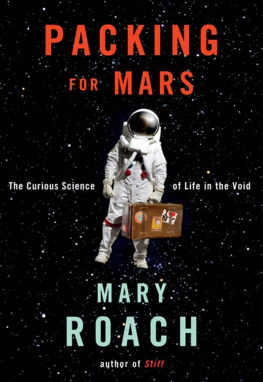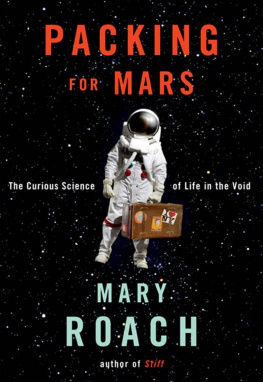PACKING FOR MARS
THE CURIOUS SCIENCE OF LIFE IN THE VOID
MARY ROACH
W. W. NORTON & COMPANY  NEW YORK
NEW YORK  LONDON
LONDON
Copyright 2010 by Mary Roach
All rights reserved
Photograph credits: Frontmatter: Hamilton Sundstrand Corporation 2010.
All rights reserved; Chapter 1: Image by Deirdre ODwyer; Chapter 2: Dmitri Kessel / Time & Life Pictures / Getty Images; Chapter 3: Courtesy of NASA; Chapter 4: CBS Photo Archive / Hulton Archive / Getty Images; Chapter 5: Courtesy of NASA; Chapter 6: Image Source / Getty Images; Chapter 7: Courtesy of NASA; Chapter 8: Bettman/Corbis; Chapter 9: Ryan McVay / Riser / Getty Images; Chapter 10: Courtesy of NASA; Chapter 11: Hulton Archive / Getty Images; Chapter 12: Joanna McCarthy / Riser / Getty Images; Chapter 13: Hulton Archive / Getty Images; Chapter 14: Courtesy of NASA; Chapter 15: Courtesy of NASA; Chapter 16: Tim Flach / Stone+ / Getty Images
For information about permission to reproduce selections from this book, write to Permissions, W. W. Norton & Company, Inc., 500 Fifth Avenue, New York, NY 10110
Library of Congress Cataloging-in-Publication Data
Roach, Mary.
Packing for Mars: the curious science of life in the void / Mary Roach.1st ed.
p. cm.
Includes bibliographical references.
ISBN: 978-0-393-07910-4
1. Space biologyPopular works. I. Title.
QH327.R63 2010
571.0919dc22
2010017113
W. W. Norton & Company, Inc.
500 Fifth Avenue, New York, N.Y. 10110
www.wwnorton.com
W. W. Norton & Company Ltd.
Castle House, 75/76 Wells Street, London W1T 3QT
For Jay Mandel and Jill Bialosky,
with cosmic gratitude
CONTENTS
Japan Picks an Astronaut
The Perilous Psychology of Isolation and Confinement
Can Space Blow Your Mind?
The Alarming Prospect of Life Without Gravity
Escaping Gravity on Board NASAs C-9
The Astronauts Secret Misery
NASA Visits the Crash Test Lab
The Strange Careers of Ham and Enos
Planning a Moon Expedition Is Tough, but Not as Tough as Planning a Simulated One
Space Hygiene and the Men Who Stopped Bathing for Science
What If You Never Got Out of Bed?
Mating Without Gravity
Bailing Out from Space
The Continuing Saga of Zero-Gravity Elimination
When Veterinarians Make Dinner, and Other Tales of Woe from Aerospace Test Kitchens
Is Mars Worth It?
PACKING FOR MARS

COUNTDOWN
T o the rocket scientist, you are a problem. You are the most irritating piece of machinery he or she will ever have to deal with. You and your fluctuating metabolism, your puny memory, your frame that comes in a million different configurations. You are unpredictable. Youre inconstant. You take weeks to fix. The engineer must worry about the water and oxygen and food youll need in space, about how much extra fuel it will take to launch your shrimp cocktail and irradiated beef tacos. A solar cell or a thruster nozzle is stable and undemanding. It does not excrete or panic or fall in love with the mission commander. It has no ego. Its structural elements dont start to break down without gravity, and it works just fine without sleep.
To me, you are the best thing to happen to rocket science. The human being is the machine that makes the whole endeavor so endlessly intriguing. To take an organism whose every feature has evolved to keep it alive and thriving in a world with oxygen, gravity, and water, to suspend that organism in the wasteland of space for a month or a year, is a preposterous but captivating undertaking. Everything one takes for granted on Earth must be rethought, relearned, rehearsedfull-grown men and women toilet-trained, a chimpanzee dressed in a flight suit and launched into orbit. An entire odd universe of mock outer space has grown up here on Earth. Capsules that never blast off; hospital wards where healthy people spend months on their backs, masquerading zero gravity; crash labs where cadavers drop to Earth in simulated splash-downs.
A couple years back, a friend at NASA had been working on something over in Building 9 at the Johnson Space Center. This is the building with the mock-ups, some fifty in allmodules, airlocks, hatches, capsules. For days, Rene had been hearing an intermittent, squeaking racket. Finally, he went to investigate. Some poor guy in a spacesuit running on a treadmill suspended from a big complicated gizmo to simulate Martian gravity. Lots of clipboards and timers and radio headsets and concerned looks all around. It occurred to me, reading his email, that its possible, in a way, to visit space without leaving Earth. Or anyway, a sort of slapstick-surreal make-believe edition. Which is more or less where Ive been these past two years.
O F THE MILLIONS of pages of documents and reports generated by the first moon landing, none is more telling, to me anyway, than an eleven-page paper presented at the twenty-sixth annual meeting of the North American Vexillological Association. Vexillology is the study of flags, not the study of vexing things, but in this case, either would fit. The paper is entitled Where No Flag Has Gone Before: Political and Technical Aspects of Placing a Flag on the Moon.
It began with meetings, five months before the Apollo 11 launch. The newly formed Committee on Symbolic Activities for the First Lunar Landing gathered to debate the appropriateness of planting a flag on the moon. The Outer Space Treaty, of which the United States is a signer, prohibits claims of sovereignty upon celestial bodies. Was it possible to plant a flag without appearing to be, as one committee member put it, taking possession of the moon? A telegenically inferior plan to use a boxed set of miniature flags of all nations was considered and rejected. The flag would fly.
But not without help from the NASA Technical Services Division. A flag doesnt fly without wind. The moon has no atmosphere to speak of, and thus no wind. And though it has only about a sixth the gravity of Earth, that is enough to bring a flag down in an inglorious droop. So a crossbar was hinged to the pole and a hem sewn along the top of the flag. Now the Stars and Stripes would appear to be flying in a brisk windconvincingly enough to prompt decades of moon hoax jabberthough in fact it was hanging, less a flag than a diminutive patriotic curtain.
Challenges remained. How do you fit a flagpole into the cramped, overpacked confines of a Lunar Module? Engineers were sent off to design a collapsible pole and crossbar. Even then, there wasnt room. The Lunar Flag Assemblyas flag, pole, and crossbar had inevitably come to be knownwould have to be mounted on the outside of the lander. But this meant it would have to withstand the 2,000-degree Fahrenheit heat generated by the nearby descent engine. Tests were undertaken. The flag melted at 300 degrees. The Structures and Mechanics Division was called in, and a protective case was fashioned from layers of aluminum, steel, and Thermoflex insulation.
Just as it was beginning to look as though the flag was finally ready, someone pointed out that the astronauts, owing to the pressurized suits theyd be wearing, would have limited grip strength and range of motion. Would they be able to extract the flag assembly from its insulated sheath? Or would they stand there in the gaze of millions, grasping futilely? Did they have the reach needed to extend the telescoping segments? Only one way to know: Prototypes were made and the crew convened for a series of flag-assembly deployment simulations.













 NEW YORK
NEW YORK 